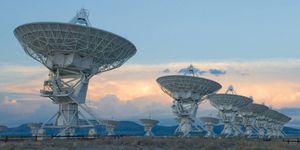Could Machine Learning Be Used to Find Extraterrestrial Life?
“Are we alone in the Universe?”
That is a grand question that scientists have been trying to answer for quite some time now. The search for extraterrestrial intelligence (SETI) looks for evidence of alien civilizations. Scientists try to detect technosignatures – evidence of technology – that could have been produced by intelligent alien lifeforms. It is believed that these technosignatures would take the form of radio waves. Humans use radio waves to send information over long distances in our own Solar System, and thus many SETI efforts use antennas to search for radio signals an alien race might be transmitting.
SETI experiments began back in 1960 when Frank Drake pursued Project Ozma at the Green Bank Observatory. Since these early experiments, technological advances have allowed researchers to collect more data than ever. Massive amounts of data require novel computational techniques to process and analyze the sheer amount of information in a quick and efficient way to be able to identify anomalies that could be evidence of extraterrestrial intelligence.
Scientists have begun to borrow techniques from machine learning to help search for technosignatures to see if we are alone in the Universe. New research that has been published in the journal Nature Astronomy presents an application of machine learning techniques to previously analyzed datasets, which has revealed formerly undetected signals of interest.
The study took a second look at data taken with the Green Bank Telescope as part of the Breakthrough Listen campaign. The dataset consisted of 150 TB of data, looking for signals from 820 nearby stars. This dataset was originally examined in 2017 with a classical search algorithm, and indicated that there were no targets of interest. However, the deep learning algorithm uncovered eight previously unidentified signals of interest.
The results of the study illustrate the power of applying machine learning techniques to the new challenges of extremely large data sets in astronomy. These techniques will yield faster and more accurate results, transforming the field of astronomy in general.
In terms of SETI, these new techniques will accelerate the rate at which astronomers will find signals, thus allowing for faster follow-up observations to try to re-detect the signals. The team wants to apply this technique to future datasets, scaling their search radius to 1 million stars. Perhaps we will have an answer to the grand question sooner than we thought!
Source: SETI Institute








